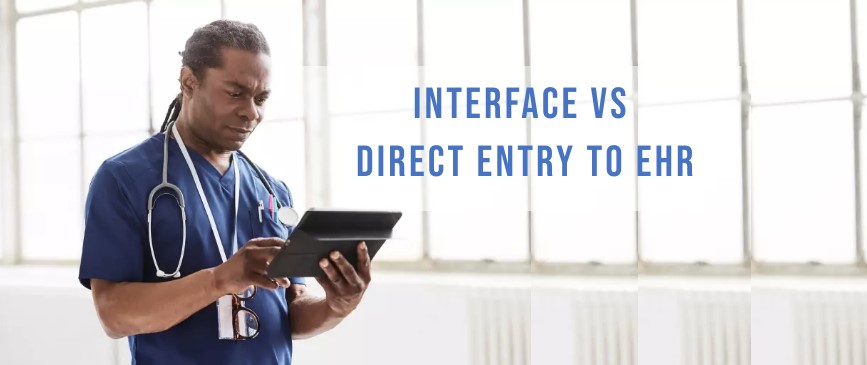Interface vs Direct Entry to EHR: Which Path to Choose for Optimal Healthcare?
Jul 31, 2023 | Deanna CavanaghElectronic Health Records (EHR) have revolutionized the way healthcare providers manage patient information, streamlining processes, improving efficiency, and enhancing patient care. As EHR systems continue to evolve, two prominent methods of data entry have emerged: Interface and Direct Entry. In this blog post, we will explore the differences between these two methods, their advantages and disadvantages, and provide guidance on choosing the best approach for your healthcare organization.

Understanding Interface Data Entry
Interface data entry involves the use of third-party applications or medical devices to automatically transfer data into the EHR system. These interfaces can be set up with various devices, such as diagnostic imaging systems, laboratory equipment, and monitoring devices, allowing for seamless integration of patient data.
Advantages of Interface Data Entry:
- Automation: Interfaces reduce manual data entry, thereby minimizing the risk of human error, improving data accuracy, and increasing efficiency.
- Time-saving: Automated data transfer frees up healthcare staff to focus on more critical tasks, ultimately enhancing patient care.
- Consistency: Interface data entry helps maintain consistency in data format and presentation, facilitating easier analysis and interpretation.
Disadvantages of Interface Data Entry:
- Cost: Setting up interfaces can be expensive, as it often requires custom development, specialized hardware, and ongoing maintenance.
- Compatibility: Not all devices or systems are compatible with every EHR system, leading to potential issues with data transfer and integration.
Delving into Direct Entry
Direct Entry refers to the manual input of patient data into the EHR system by healthcare staff, such as physicians, nurses, and administrative personnel. This method allows for the direct input of information, often through templates or forms within the EHR system.
Advantages of Direct Entry:
- Flexibility: Direct Entry allows healthcare providers to input data in a more personalized and detailed manner, which can be beneficial for complex or unique cases.
- Cost-effectiveness: Direct Entry does not require additional hardware or software, making it a more affordable option for smaller healthcare organizations.
- Control: Healthcare staff have greater control over the data input process, ensuring that information is accurate and complete.
Disadvantages of Direct Entry:
- Time-consuming: Manual data entry can be labor-intensive and time-consuming, detracting from direct patient care.
- Human error: The risk of human error is higher with Direct Entry, which can lead to inaccuracies in patient records.
- Inconsistency: Data entered manually may not be as consistent in format and presentation, making analysis and interpretation more challenging.
Choosing the Right Path
When deciding between Interface and Direct Entry for your EHR system, consider the following factors:
- Size and resources: Larger organizations may benefit from the automation and efficiency offered by Interface data entry, while smaller practices may find Direct Entry more cost-effective.
- Patient population: If your practice sees a high volume of patients with complex conditions, Direct Entry may provide more flexibility and detail in documenting patient information.
- Staff preferences: Evaluate your healthcare team’s comfort level with technology and their preferences for data entry methods.
- Compatibility: Ensure that your chosen method is compatible with your existing EHR system and medical devices.
Both Interface and Direct Entry methods have their benefits and drawbacks, and the optimal choice depends on the unique needs and preferences of your healthcare organization. By carefully considering the factors outlined above, you can make an informed decision on the best data entry method for your EHR system, ultimately enhancing patient care and improving overall efficiency.

As a leading provider of medical transcription and EHR documentation services, ZyDoc can assist healthcare providers in optimizing their EHR workflows by offering an innovative interface solution. Our EHR documentation platform enables healthcare providers to document patient encounters easily and accurately, while reducing the time and effort required to enter data into an EHR. Healthcare providers can access patient data in real-time, create customizable templates, and use voice-to-text technology to dictate patient notes, which are then converted into structured data that can be easily integrated into any EHR system. By partnering with ZyDoc, healthcare providers can streamline their EHR workflows, reduce errors, and improve patient outcomes.
